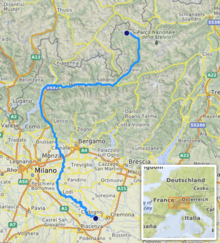Adda (river)
| Adda | |
|---|---|
 The Adda in Imbersago | |
 Location of the Adda | |
| Location | |
| Countries | Italy, Switzerland |
| Physical characteristics | |
| Source | Val Alpisella[1] |
| • location | east of Livigno, Italy |
| • coordinates | 46°32′50.64″N 10°14′21.12″E / 46.5474000°N 10.2392000°E |
| • elevation | 2,122 m (6,962 ft) |
| Mouth | Po |
• coordinates | 45°08′04″N 9°52′54″E / 45.13444°N 9.88167°E |
| Length | 313 km (194 mi) |
| Basin size | 7,979 km2 (3,081 sq mi) |
| Discharge | |
| • average | 187 m3/s (6,600 cu ft/s) |
| Basin features | |
| Progression | Po→ Adriatic Sea |
| Tributaries | |
| • left | Brembo Serio |
| • right | Mallero Mera |
The Adda (Latin: Abdua, or Addua; Lombard: Ada or, again, Adda in local dialects where the double consonants are marked) is a river in North Italy, a tributary of the Po. It rises in the Alps near the border with Switzerland and flows through Lake Como. The Adda joins the Po a few kilometres upstream of Cremona. It is 313 kilometres (194 mi) long. The highest point of the drainage basin is the summit of la Spedla (a subpeak of Piz Bernina), at 4,020 metres (13,190 ft).
Towns along the river Adda include Bormio, Tirano, Sondrio, Bellagio and Lecco (both on Lake Como), Brivio and Lodi. One tributary, the Poschiavino, arises in Switzerland and runs through the town of Poschiavo.
Course
[edit]The Adda's true source is in Alpisella valley near the head of the Fraele glen, but its volume is increased by the union with several smaller streams, near the town of Bormio, at the Rhaetian Alps. Thence it flows first southwest, then due west, through the fertile Valtellina, passing Tirano, where the Poschiavino falls in on the right bank, and Sondrio, where the Mallero joins, also on the right. This first half of the course of the Adda makes it the only big river of northern Italy to flow from east to west. It falls into Lake Como, at its northern end, and mainly forms that lake. On issuing from its southeastern or Lecco arm, it crosses the plain of Lombardy where it is joined from the left by the Brembo, Serio, and finally, after a course of about 313 kilometres (194 mi), joins the Po, 13 kilometres (8 mi) above Cremona.[2]
The Trezzo sull'Adda Bridge, erected in 1377, holds the world record of 72 metres (236 ft) for the longest bridge arch built before the introduction of metal into bridge construction.
The lower course of the Adda was formerly the border between the Republic of Venice and the Duchy of Milan, after the Treaty of Lodi, 1454; and on its banks several important battles have been fought, notably that of Lodi, where Napoleon defeated the Austrians in 1796;[2] several battles have also taken place at the bridgehead of Cassano d'Adda and surrounding countryside: Prince Eugene of Savoy fought the French here in 1705, and Count Alexander Suvorov forced the river in 1799.
Tributaries
[edit]The Adda has the following tributaries (R on the right bank, L on the left, from source to mouth):
-
Ferry designed by Leonardo da Vinci
-
The Adda river in Brivio
-
San Michele Bridge across the Adda at Paderno.
-
17th century map of the Adda, from Lake Como to Trezzo
See also
[edit]- Val Pola landslide
- Battle of the Adda River, fought in 490 CE
Sources
[edit]- ^ "Cartello sorgente dell'adda 2122 m" (in Italian).
- ^ a b One or more of the preceding sentences incorporates text from a publication now in the public domain: Coolidge, William Augustus Brevoort (1911). "Adda". In Chisholm, Hugh (ed.). Encyclopædia Britannica. Vol. 1 (11th ed.). Cambridge University Press. p. 183.
External links
[edit]- Kayaking in the Adda river Archived 2017-06-24 at the Wayback Machine
- Tributaries of the Po (river)
- Adda basin
- Rivers of Italy
- Rivers of the Alps
- Rivers of the Province of Bergamo
- Rivers of the Province of Como
- Rivers of the Province of Cremona
- Rivers of the Province of Lecco
- Rivers of the Province of Lodi
- Rivers of the Metropolitan City of Milan
- Rivers of the Province of Sondrio





